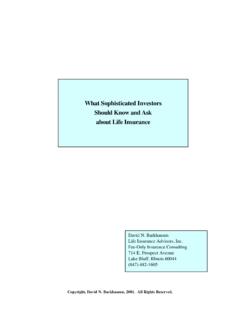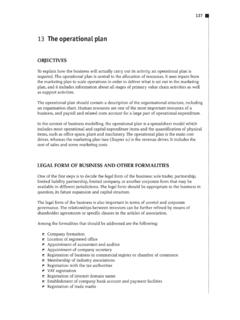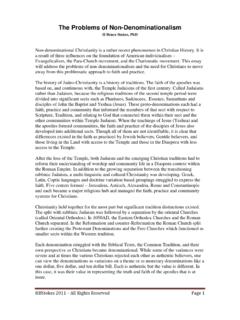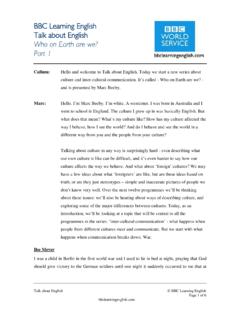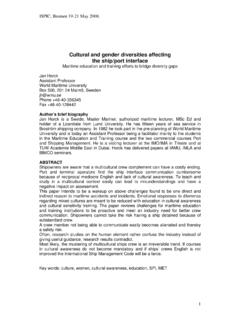Transcription of The Willie Lynch Letter And The Making of a Slave
1 The Willie Lynch LetterAndThe Making of a SlaveINTRODUCTIONThe infamous Willie Lynch Letter gives both African and Caucasian students and teachers some insight, concerning the brutal and inhumane psychology behind the African Slave trade. The materialistic viewpoint of Southern plantation owners that slavery was a business and the victims of chattel slavery were merely pawns in an economic game of debauchery, crossbreeding, interracial rape and mental conditioning of a Negroid race, they considered subhuman. INTRODUCTIONE qually important is the international nature of the European economic, political, and cultural climate, that influenced the Slave trade.
2 Within the time scale of African history, it was a relatively short period, a mere one and a half centuries from the most intensive phase of the Atlantic Slave trade to the advent of European administration and dominance. Long before that the Slave coast had been chartered by the Portuguese and the people off the area west of Benin, between the Volta River and Lagos, European traders traced a cultural history which linked them with the earliest Yoruba settlements to the north and eastern borders of Africa. INTRODUCTIONT here were considerable debates during the colonial periods in the United States, and the late 1700 s, the attention of the national government was mainly directed to slavery and the rising numbers of slaves traded and imported into the South.
3 The first debate was held in Congress, in 1789, on the question of whether taxes should be paid on imported slaves. During the debate on the slavery duty bill, which was introduced by Mr. Clymer s committee, Parker of Virginia moved that on May 13, 1789, a tax of ten dollars per capita be laid on slaves imported. INTRODUCTIONHe plainly stated that the tax was designed to check the trade, and that he was sorry that the Constitution prevented Congress from prohibiting the importation altogether. The proposal was evidently unwelcome and cause extended debate.
4 Smith of South Carolina wanted to postpone the matter so big with the serious consequences to the State he represented. Roger Sherman of Connecticut could not reconcile himself to the insertion of human beings as an article of duty, among goods, wares, and merchandise . INTRODUCTIONJ ackson of Georgia argued against any restriction, and thought such states such as Virginia ought to let their neighbors get supplied, before the imposed such a burden upon the importation. Some Congressmen argued during that Congress should wipe off the stigma under which America labored.
5 This brought Jackson again to his feet. He believed, in spite of the fashion of the day, that Negroes were better off as slaves than as freedmen, and that, as the tax was partial, it would be the most odious tax Congress could impose. INTRODUCTIONSuch sentiments were a distinct advance in pro-slavery doctrine, and called for a protest from Congressman Madison of were both moral arguments and legal positions to the question of slavery in the South. On one side, it began with the Rights of Man , and descended to sticking for it to have a decent appearance on the statute book.
6 On the other side, it began with the uplifting of the heathen; and descended to a denial of the applicability of moral principles to the question; INTRODUCTION said Hollard of North Carolina, It is admitted that the condition of slaves in the Southern states is much superior to that of those in Africa. (Holland s opinion) Who, then, will say that trade is immoral? But, in fact, morality has nothing to do with this traffic, for Joseph Clay declared, it must appear to every man of common sense, that the question could be considered in a commercial point of view only.
7 The other side declared that, by laws of God and man these capture Negroes, are entitled to their freedom as clearly and as absolutely as we are. INTRODUCTIONN evertheless, some were wiling to leave them to the tender mercies of the Slave states, so long as the statue book was not disgraced by no explicit recognition of slavery. The moral questions were argued back and forth, but there were no question of the tremendous profitability using slavery in exchange for molasses, sugar, textiles, spices, and the massive free labor of the cotton production on numerous plantations in the South.
8 The system began with a conspiratorial battle of wits between the European traders and African chiefs. INTRODUCTIONS lave traders were required to know not only the state of the trade, if they were to see a profit, but also know the likely supply of slaves available on one hand, and the likely supply of ships on the other. Also the varying values of many different standards of payment. Coins were seldom or never used on the coast. Mostly the chiefs and Slave traders dealt in rolls of tobacco, barrels of rum, and firearms and generally in lengths of iron or copper, or in pots and basins of brass.
9 The slaver s books are full of all of this. INTRODUCTIONR egardless of the economic prosperity enjoyed during the African Slave trade, and the tedious burden placed on the backs of African people, most will agree that the psychological damage, and atrocities inflicted on Black people during that point of time, and even today, are the most outrageous examples of injustice and downpressionever experienced by 1999 Kashif Malik Hassan-ELWilliam Lynch : The Untold Story 1712 This speech was delivered by a white Slave owner, William Lynch ,on the bank of the James River in The Message is Still True.
10 TODAYBy William LynchGentlemen, I greet you here on the banks of the James River in the year of our Lord one thousand seven hundred and twelve. First, I shall thank you, the gentlemen of the Colony of Virginia for bringing me here. I am here to help you solve some of your problems with slaves. Your invitation reached me on my modest plantation in the West Indies were I have experimented with some of the newest and still the oldest methods for control of slaves. Ancient Rome would envy us if my program is implemented. William Lynch : The Untold Story 1712As our boat sailed south on the James River, named for our Illustrious King, whose version of the Bible we cherish, I saw enough to know your problem is not unique.


